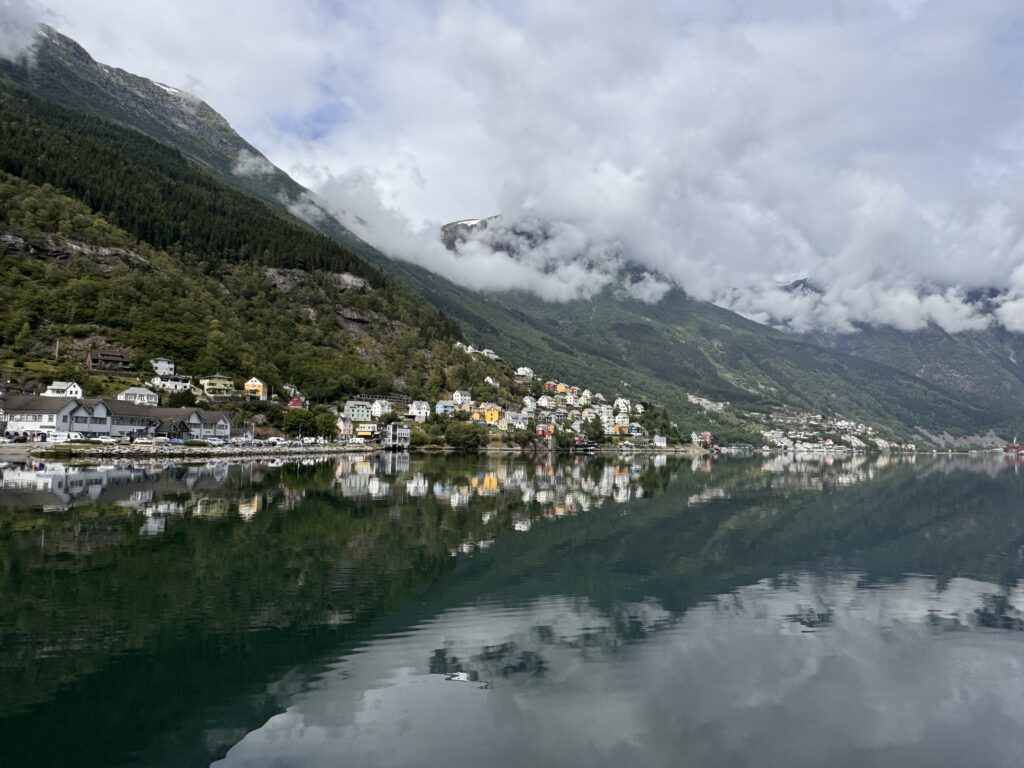Odda
Highlights
Our impression of several places we stayed at in Norway so that you may get an idea if you should consider these places for your Norway adventure.
Time of Visit: July – August 2024
Duration of Visit: 42 Days
Description
We flew into Oslo and explored the fjords in Southern Norway for 25 days. Then we returned our rental car and stayed two days just outside of the capital city. Next, we flew to Tromso and explored Senja, the Lofoten Islands and Tromso area for 15 days. Our itinerary was mainly to see scenic places and make AirBnB reservations at different communities. Here we describe why we stayed at those communities and our impressions so that you may have an idea if you should include them in your Norway itinerary.
In Southern Norway (from Oslo), we stayed in Lysebotn, Tau, Odda, Bergen, Ulvik, Sandane, Åndalsnes, Kristiansund, Trondheim and Lillestrom.
In Northern Norway (from Tromso), we stayed in Botnhamn, Svolvaer, Moskenes, Bodo and Tromso.
western fjords
Lysebotn
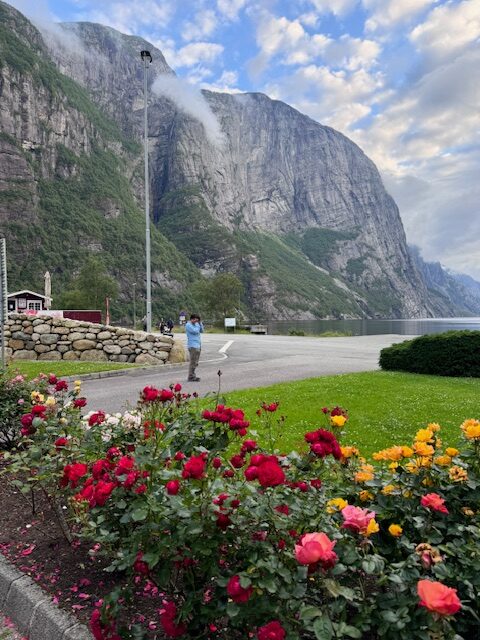

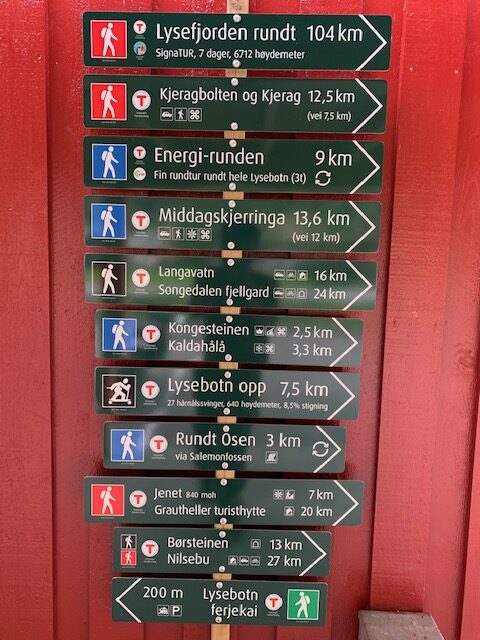

Recommended Stay: 2 nights. Longer if you plan on doing other activities other than Kjeragbolten.
Lysebotn is a small village at the east end of Lysefjord. It is quiet and not too touristy because there are limited commercial establishments. Most visitors stay at Lysebotn so they can hike to Kjeragbolten, the famous rock wedged between two cliffs. But there are certainly other hikes that can be done in the area.
It is an all day drive to get to Lysebotn from Oslo. The drive to Lysebotn is through narrow roads where in some cases is only wide enough for one vehicle. The final 50 or so kilometers to Lysebotn is alpine scenery which reminds us of Yosemite National Park’s backcountry.


The road to the village known as the Lysebotnvegen, has 27 hairpin turns plus a narrow tunnel that will test your nerves as it descends to the fjord.
In the summer, a ferry connects Lysebotn to other parts of the Lysefjord, providing a scenic and convenient way to explore the region. The ferry has a limited schedule and does not run every day of the week.


Whether visiting for the adventure or simply to take in the awe-inspiring scenery, Lysebotn offers a quintessential Norwegian fjord experience, combining natural beauty with thrilling outdoor opportunities.
Tau
Recommended Stay: 1 night
Tau was our base to do the Preikestolen hike. The Preikestolen parking lot is only a short 25 minute drive from Tau.
Tau is a fairly quiet community. We did not find anything worth exploring here. If you came from Lysebotn, you will pass by the city of Stavanger on the way to Tau. If you are considering Stavangar as a base to do the Preikestolen hike, be advised that you will have to pass through an underwater tunnel that connects Tau to Stavangar. The tunnel toll fee during our visit was around $16 USD each way.
There are certainly other communities besides Tau that are near Preikestolen but we found the most reasonably priced AirBnB in Tau.
Odda


Recommended Stay: At least three nights
Odda is a charming town located in the Hardanger region of western Norway. It is nestled between steep mountains at the southern end of the Sørfjorden, an arm of the famous Hardangerfjord.
Most people come to Odda to hike to Trolltunga (Troll’s Tongue) which is the famous rock slab perched above the blue colored Ringedalsvatnet Lake. However, there is more to see and do around Odda than Trolltunga.
In addition to hiking, Odda provides access to other outdoor pursuits, such as fishing, kayaking, and glacier walking on the nearby Folgefonna Glacier in Folgefonna National Park. The mighty Vidfossen and Låtefossen are not too far from town also. The town itself, with its colorful wooden houses and scenic fjord views, offers a peaceful retreat with a variety of local shops, cafes, and cultural attractions.
Bergen


Recommended Stay: One Night
Bergen, Norway, is a charming coastal city known for its rich history, natural landscapes, and vibrant cultural scene. One of the must-see attractions is Bryggen, the historic harbor district that dates back to the Hanseatic League era. This UNESCO World Heritage Site features colorful wooden buildings, narrow alleyways, and small shops selling local crafts.
The city has a lively fish market which is located at the harbor. It is a great place to experience local cuisine and fresh seafood. Best of all, you will pass by it on the way to see Bryggen.
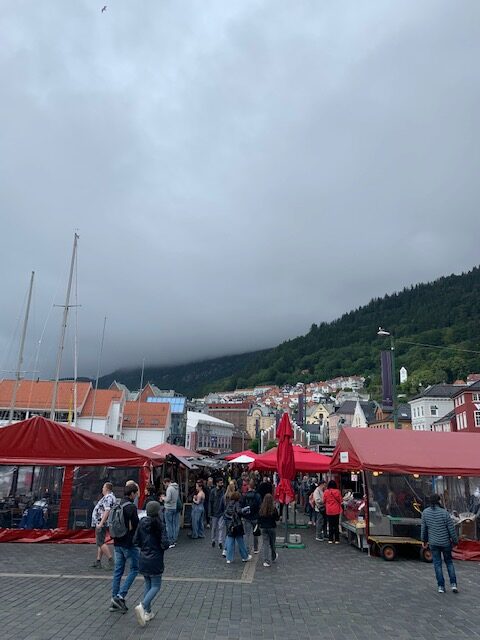

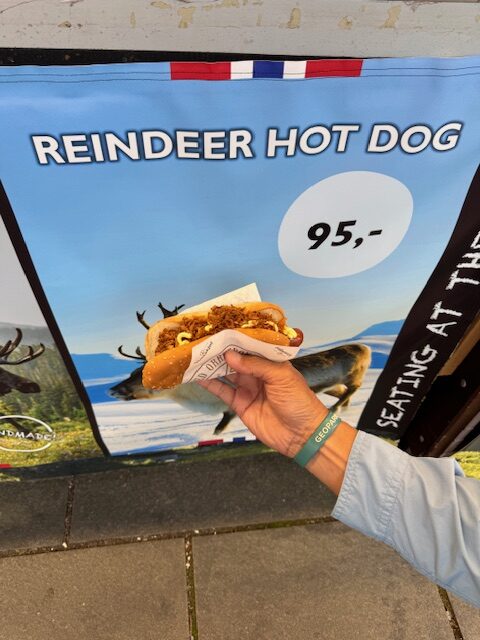

The city is surrounded by seven mountains which offer hiking opportunities. Mount Fløyen is particularly popular, accessible by a funicular that provides views of the city and fjords below. For a more challenging hike, Mount Ulriken, the highest of the seven, offers panoramic vistas and can be reached by a combination of cable car and trails.
We came to Bergen just to see Bryggen hence only recommending a one night stay. You can certainly stay longer if you are a city person and visit museums, do some shopping or hiking. But for us, we would rather be in an uncongested and quiet atmosphere where nature is unspoiled.
Ulvik
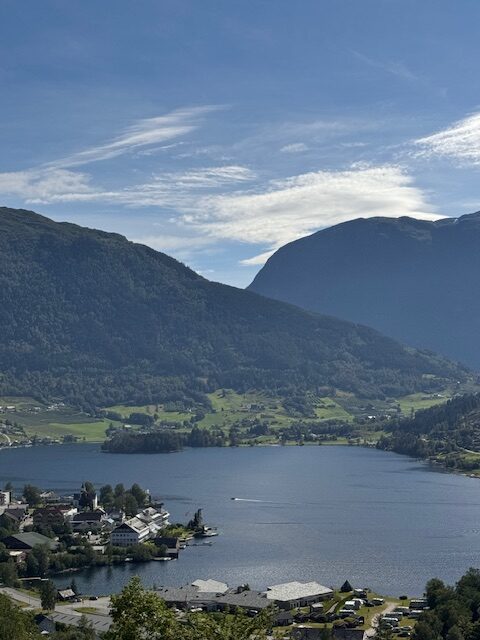

Recommended Stay: At Least Two Nights
Ulvik is a picturesque village situated in the Hardanger region of western Norway. It is a quiet village spared from the tourists who normally flock to Eidfjord instead.
Its idyllic setting along the shores of the Ulvikafjorden, a branch of the larger Hardangerfjord just begs you to slow down, relax and just sit back. Surrounded by lush orchards, rolling hills, and snow-capped mountains (season dependent), Ulvik is often referred to as the “Pearl of Hardanger” for its natural beauty and tranquil atmosphere.
The village is particularly famous for its apple orchards which is a key part of the Hardanger region’s cider production. As such, Ulvik holds the annual Hardanger Cider Festival. Even if you visit when there is no festival, you can do the Fruit and Cider Route. The route connects the three fruit farms – Hakastad Gard/Ulvik Frukt og Cideri, Syse Gard and Lekve Gard/Hardanger Saft og Siderfabrikk which are all within walking distance from each other.
Ulvik offers a variety of outdoor activities such as biking, fishing, hiking and kayaking. So the recommended two night stay can be extended if you want to partake in such outdoor activities. For us, doing the Fruit and Cider Route and driving to the nearby village of Osa was sufficient for a day’s worth of relaxing activity.
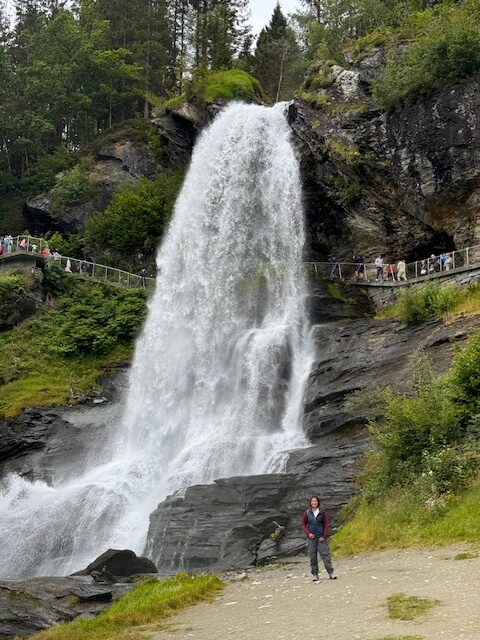

On our way to Ulvik from Bergen, we passed by Steindalsfossen and the villages of Norheimsund, Øystese and Alvik. Steinsdalsfossen reminded us of Seljalandsfoss in Iceland where you can walk behind it. There is a tourist information office at the fall’s parking lot where you can get hiking information near the three villages mentioned earlier.
What we are trying to say here is if your schedule allows it, consider staying a couple of nights or more to explore the outdoor opportunities here. That is how we found out about Vikedalsnebbet hike near Alvik and was certainly happy to have done it.
Lærdal
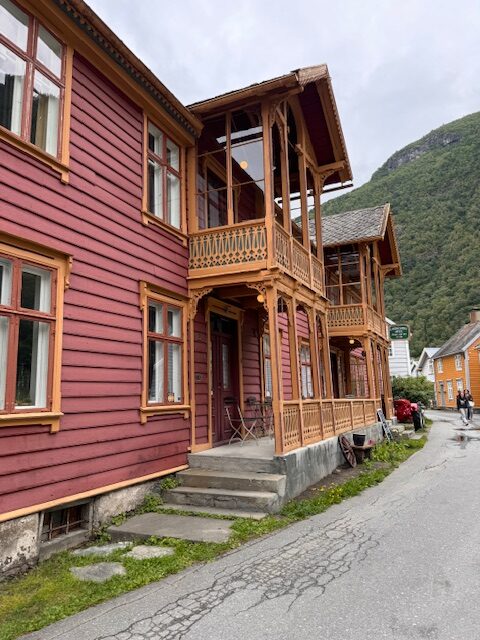

Recommended Stay: Skip
We stayed two nights in Lærdal at a campground that has cabins by the shores of Lærdalsfjord, a branch of the Sognefjord. We arrived in the late afternoon on our first night and it rained out most of the following day so we were not able to explore the surrounding area.
Lærdal is a small community. There are some historic buildings but that would only give you no more than an hour of walking around. However, this is the place to be if you are a salmon fisherman. The Laerdal River is popular for salmon fishing.
We picked Lærdall because we could not get any accommodations in Flåm and Aurland. Flam was a disappointment for us. It felt like being in Disneyland with a sea of humanity flocking to the touristy area. We just checked the shops and left.
Aurland is much quieter than Flåm and would have been a nice place to stay. The famous Stegastein Viewpoint is a short 15 minute drive from the village up the mountain. We also found some nice short hikes in Aurland on Alltrails. If we have to do it over, we would skip Lærdal and just continue on to Sogndal which is not too far away.
Sogndal


Recommended Stay: At least three nights.
Sogndal is a vibrant town located in the heart of the Sogn og Fjordane region in western Norway. It sits along the shores of the majestic Sognefjord, the longest and deepest fjord in Norway. Sogndal has a small mall that was not terribly crowded nor busy during our visit.
The Sogn og Fjordane region is a beautiful area. Blue colored fjord water flanked by towering mountains are everywhere. Sogndal is only one of many communities that are worth staying. There are many other communities that are equally picturesque that are worth a visit or a stay.


Outdoor activities are a major draw in Sogndal and the region. There are numerous opportunities for hiking, skiing, and water sports. In the summer, visitors can explore a variety of hiking trails. Molden is one such hike that rewards hikers with breathtaking views. Its trailhead is less than 30 minutes away from Sogndal.
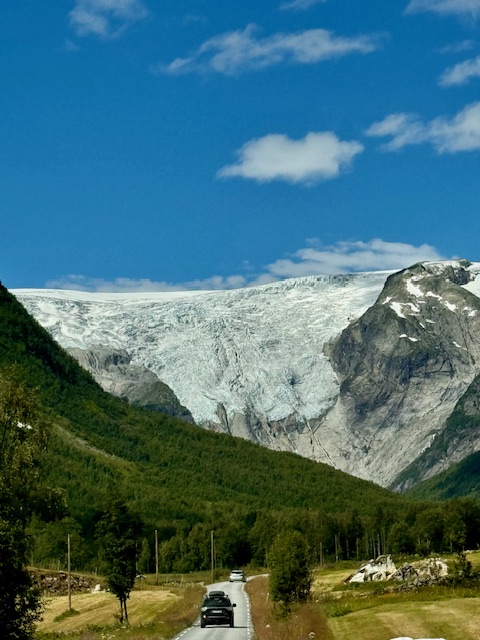

About an hour from Sogndal is Jostedalsbreen National Park, home to the largest glacier on mainland Europe. Adventurers can do two glacier hikes here, Bersetbreen and Tuftebreen, with the latter providing an opportunity to touch the glacier’s leading edge.
Whether you’re drawn by the outdoor adventures or the scenic beauty, Sogndal offers a rich and diverse experience that captures the essence of Norway’s fjord country.
Sandane
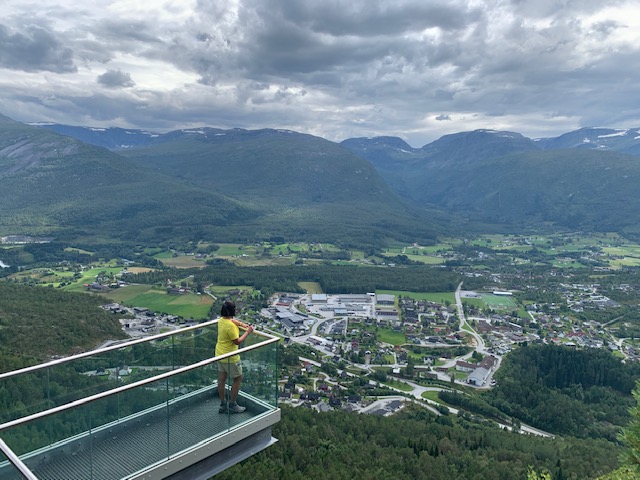

Recommended Stay: One to three nights
Sandane is a small, picturesque town located in the Gloppen municipality of western Norway. It is nestled at the end of Gloppefjorden, an arm of the larger Nordfjord. Surrounded by rolling hills, lush forests, and towering mountains, Sandane is known for its tranquil setting and stunning natural beauty.
We stayed in Sandane because we could not find any reasonably priced accommodations in Olden and Styrn. So Sandane became our base to explore the northern section of Jostedalsbreen National Park where we were able to do the Briksdalsbreen and Kattnakken hikes. It was less than an hour drive to the national park from Sandane.
Sandane is spared from tourists so it is quiet. The town has a small golf course right beside a powerful waterfall. Not well known but equally appealing as Steigastein is the Holvikfossen Viewpoint. This viewpoint provides a nice view of the fjord and the town below. Best of all, you do not have to fight crowds to snap a selfie. And if you time it correctly, you can pick wild blueberries.
We passed by Olden and Stryn on our way to Åndalsnes. If you are debating which of the two towns to stay during your travel, we would recommend Stryn. Styrn’s main street is lined with shops and restaurants and provides a lively atmosphere. You may end up spending time here looking for a good deal on outdoor apparel like we did.
Åndalsnes
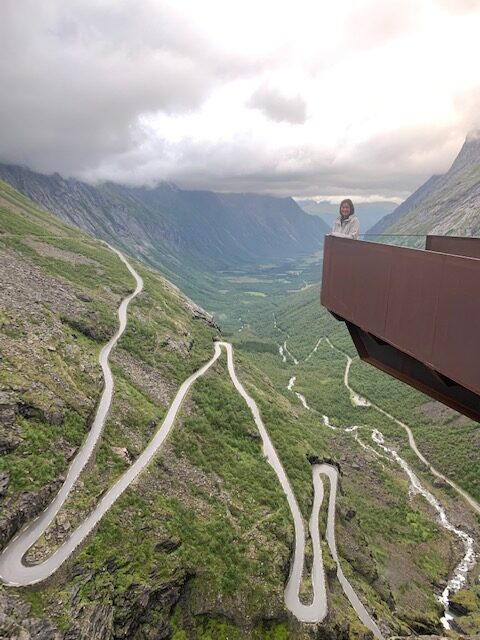

Recommended Stay: Three Nights Or Longer
Åndalsnes claims that it is the mountain capital of Norway. That is a big claim but it has the goods to back it up. Situated at the mouth of the Rauma River where it meets the Romsdalsfjord, Åndalsnes is surrounded by some of Norway’s most dramatic mountain landscapes, making it a popular destination for outdoor enthusiasts and nature lovers.
The town itself is not that exciting. But its location makes up for everything because it serves as a gateway to the Romsdalen region. It is particularly famous for its proximity to iconic natural landmarks like the Trollstigen, Trollveggen (highest vertical rock face in Europe), the Romsdalseggen Ridge (hiking) and Rampestreken (viewpoint).
Check the road condition first if you plan to see or even drive Trollstigen. Trollstigen was closed during our visit so we had to drive for two hours around the island to reach Åndalsnes.


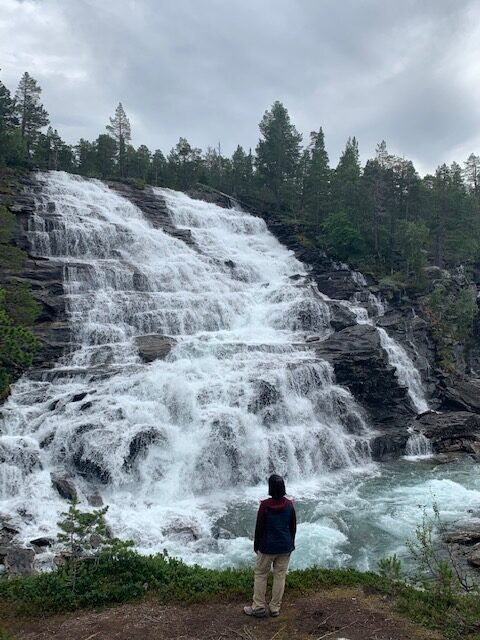

We did not do the Romsdalseggen hike as we did not have the time. Instead, we headed south on Hwy E136 up to the village of Bjorli. This is a beautiful drive through the valley carved by the Rauma River. We picked this drive because of the several waterfalls that were along the highway according to Google Maps. Unfortunately, most were not visible or accessible.
But we discovered a nice area by just turning into one of the side roads just past the Romsdalen Bridge. We saw waterfalls, an emerald colored river and a shallow canyon. We also picked wild blueberries. And we had the place all to ourselves.
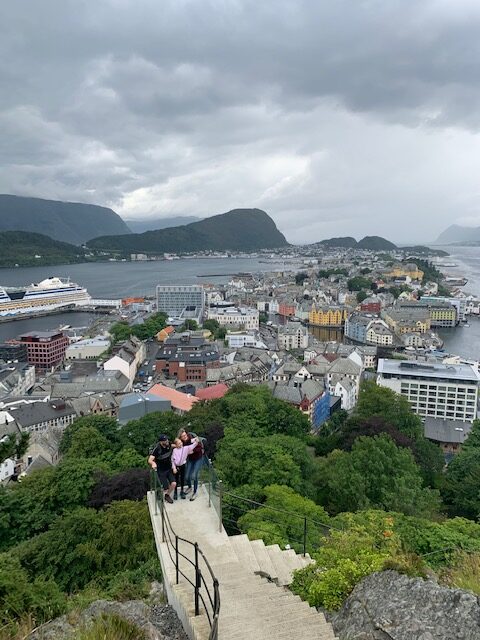

We drove over to Alesund on our last night. Alesund is only an hour drive away from Åndalsnes. You will like Alesund if you like Byrggen. The city has colorful buildings right beside a marina. The city also has several historic buildings, shops and restaurants. If your legs are inkling for a short workout, head on over to the Fjellstua viewpoint where you can tackle a couple of hundred steps and get a birds eye city view.
Kristiansund
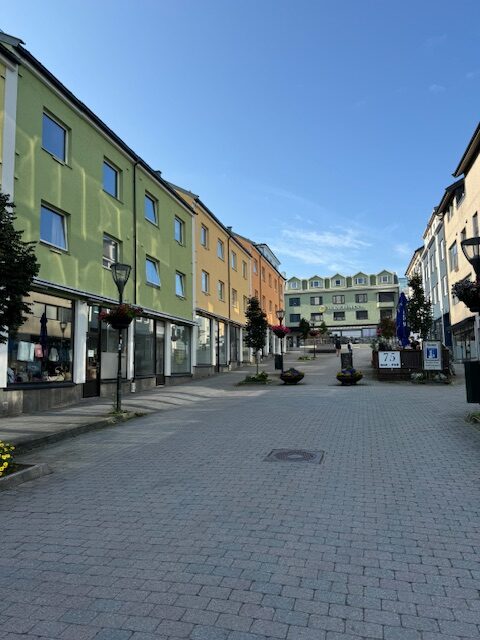

Recommended Stay: One night
We spent a couple of nights in Kristiansund because we had to break the drive between Andalsnes and Trondheim. Kristiansund is not too far from the famous Great Atlantic Ocean Road which is an eight kilometer road that connects several small islands. We have mixed feelings about this famous road. Yes it is unique but there was nothing that got us excited scenery wise.


Kristiansund does have a marina in the old town area with shops and restaurants. But the place was almost dead during our visit. Perhaps it was the time of the year or it is just how it is. We do not know as we did not ask our host or any local. Anyway, there was nothing exciting we found in this town during our research and our two night stay.
Trondheim
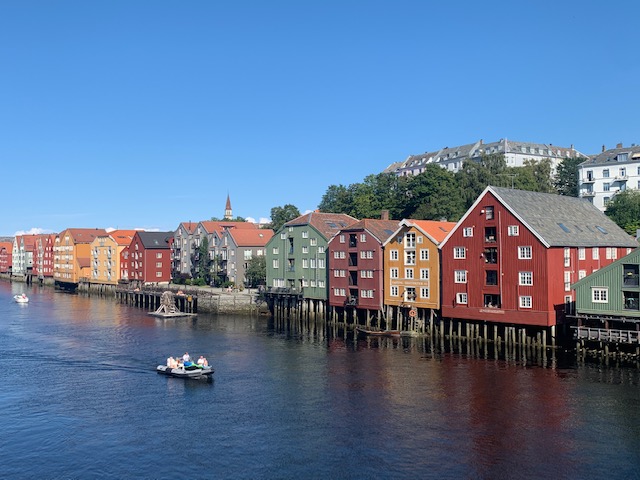

Recommended Stay: Two Nights
Trondheim is one of Norway’s oldest and most historically significant cities. It is the third-largest city in Norway and is known for its rich cultural heritage. Being a large city, we only focused our exploration in walking around its historic area. We visited the Nidaros Cathedral, mingled with the locals during a festival, walked a historic bridge and neighborhood.
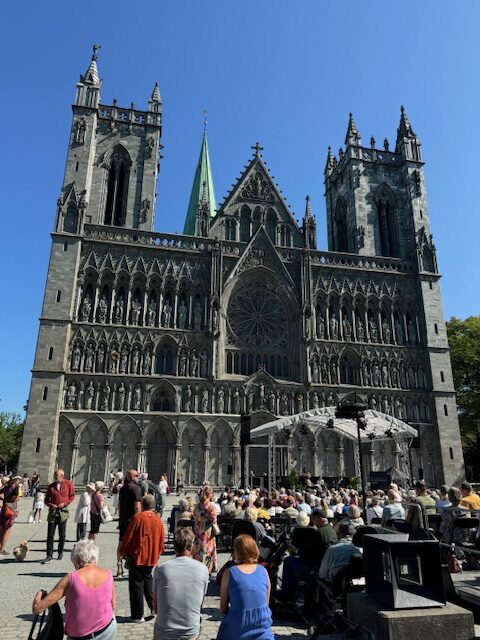

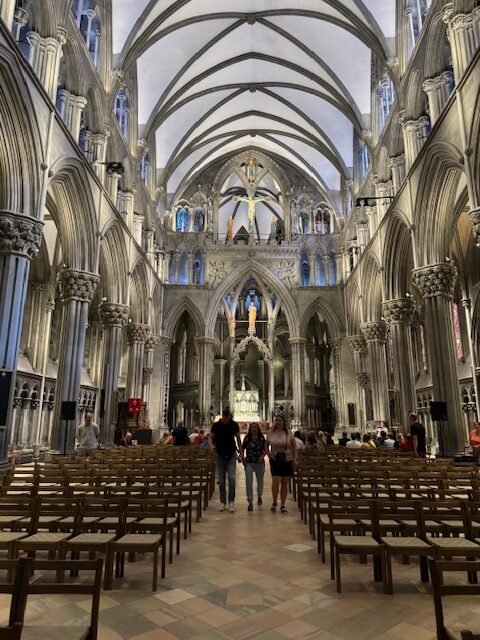

The Nidaros Cathedral is the largest medieval building in Scandinavia and the northernmost Gothic cathedral in the world. It is built over the burial site of St. Olav, the patron saint of Norway. The cathedral is km 0 for pilgrims doing the St. Olav Way which is the Scandinavian version of The Camino in Spain. The cathedral is also the traditional site for the coronation of Norwegian kings.
We were fortunate to be there during the last day of two festivals, Olavsfest and Barnas Matfestival. There were lots of vendors mainly selling food, drinks and some souvenirs. There was even an outdoor beer garden as if it was Octoberfest. It was very lively.
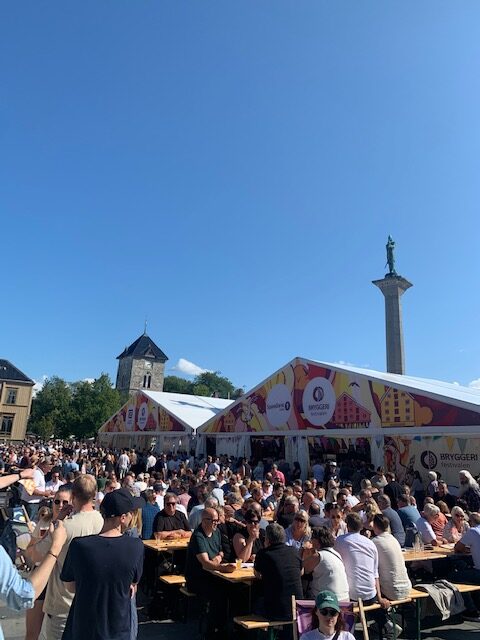

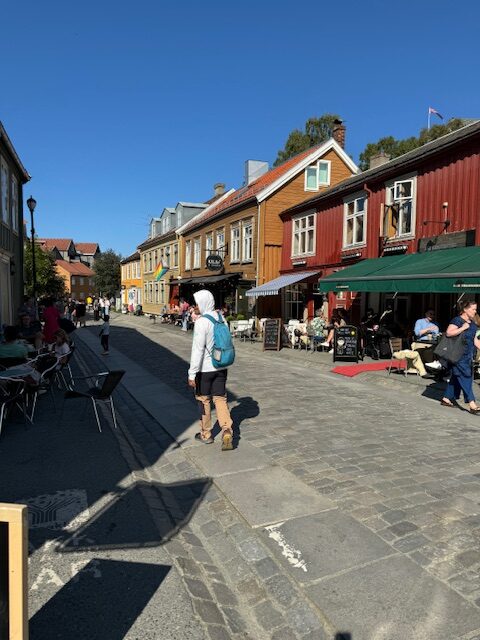

The Old Town Bridge is a pedestrian only bridge. It provides a nice viewpoint of colorful buildings built along the Nidelva River. These colorful wooden buildings are in the Bakklandet district. The district also has cobblestone streets and cozy cafes which makes it a popular area for both locals and visitors to explore.
Lillestrom
Recommended Nights: However Long You Need Before You Leave Oslo
We picked Liliestrom because the AirBnB accommodations there were cheaper than in downtown Oslo. The town is compact and very walkable to the train station. We can hop on a train and get to the airport in less than 15 minutes and to the Oslo central station in about 30 minutes.
Lilliestrom has a suburban feeling with a decent amount of shops and restaurants. Other than those, there was not much happening so it justs serves as the transition for the next leg of the journey.
Northern Norway
Senja


Recommended Stay: You can spend a week here if you are an avid hiker.
Senja is a large island that has mountains and fjords. This combination provides stunning scenery in almost every turn. It is such a beautiful island to explore. There are a multitude of hiking trails that always involve ascending to spectacular viewpoints. Mount Hesten and Mount Senja are two popular hiking trails on the island.
Being a large island, it is best to move around with respect to your accommodation so you do not end up spending a lot of time and gas driving around. It is fairly safe to assume that you would not go wrong if you pick a seaside community as your base.
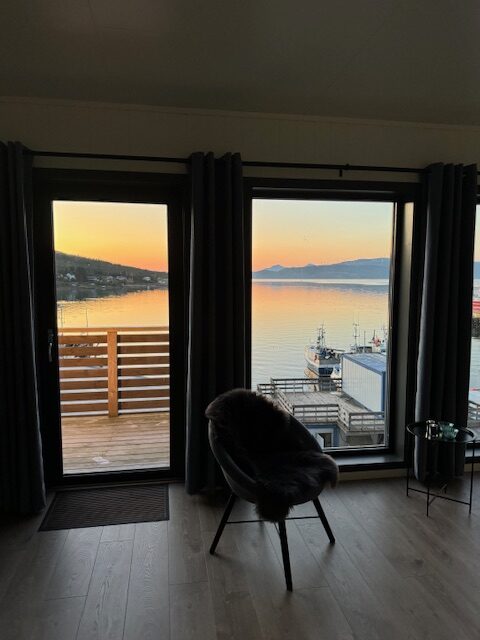

We stayed in Botnhamn, a small picturesque village nestled along the shores of the Botnhamn Bay. Though the village only has a few buildings, a grocery store and a marina, the view from our accommodation was just priceless. Hamn is also a nice village with accommodations that is more centrally located among the attractions in Senja.


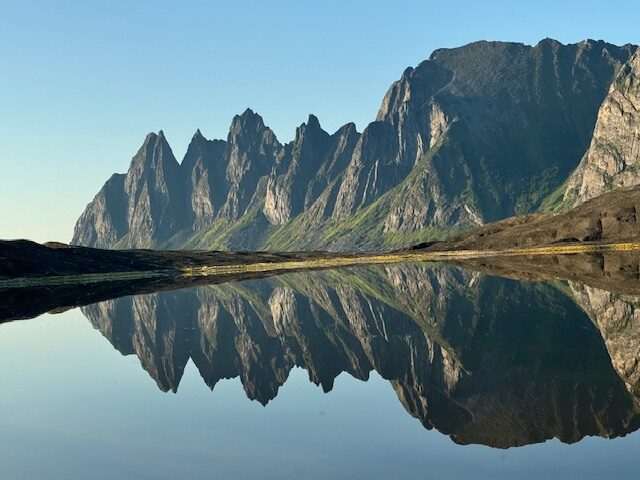

Do not miss out on visiting the Tungeneset and Bergsbotn utsiktsplattform (viewpoint). Tungeneset provides a dramatic view of jagged mountain peaks while Bergsbotn provides a spectacular view of the fjord below. Driving over to the villages of Gryllefjord and Torsken provides a nice scenic road trip. If you fancy camping on a beach or taking a dip, head on over to Ersfjord Beach. There is simply so much to see and do in the island of Senja.
Senja has fewer motorists which makes driving the narrow roads more enjoyable. But do not get complacent and assume you will have the road all to yourself all the time.
Svolvær


Recommended Stay: Three nights or longer
Svolvær is the largest town in the Lofoten archipelago. It is an ideal destination for summer outdoor activities because of stunning natural landscapes and a variety of adventurous pursuits.
Nestled between dramatic mountains and the open sea, Svolvær is a haven for hikers, with numerous trails leading to breathtaking viewpoints. We did a couple of hikes here, the Tuva and Djevelporten. Both are short challenging hikes with fantastic views. However, we would give the edge to Djevelporten as the destination is unique.
If you missed hiking Kieragbolten, Djevelporten provides a similar experience but at a much shorter hike. The destination is a car sized rock wedged between two cliffs. You can safely stand on the rock to snap a thrilling photo.
Another hike that we read about is Svolværgeita, a distinctive rock formation that attracts climbers and offers panoramic views of the surrounding islands and fjords. And there are other less challenging but equally rewarding hikes that include paths that meander though lush valleys, along coastal cliffs, and up to serene lakes.
For those who enjoy being on the water, Svolvær provides excellent opportunities for kayaking and fishing. Kayaking through the calm waters of the Lofoten archipelago allows visitors to explore hidden coves, picturesque fishing villages, and secluded beaches. Fishing enthusiasts can try their luck at sea fishing, where cod and other species are plentiful.
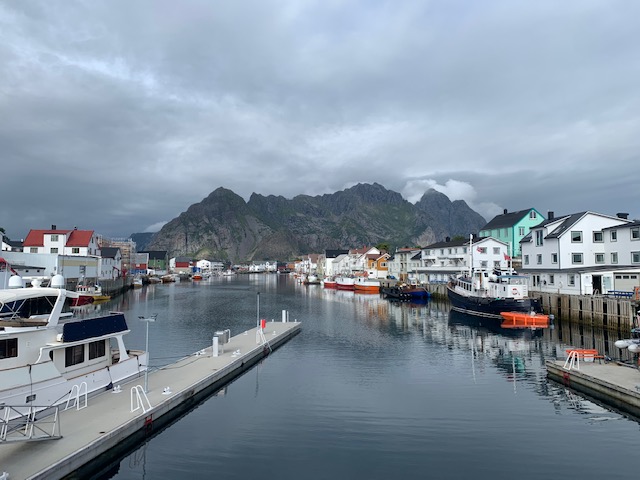

About 30 minutes by car from Svolvær is the quaint and colorful fishing village of Henningsvær. Allow at least half a day to visit this village if you are going to base yourself in Svolvær.
Svolvær in the summer offers a perfect blend of outdoor experiences amidst one of Norway’s most beautiful landscapes.
Moskenes
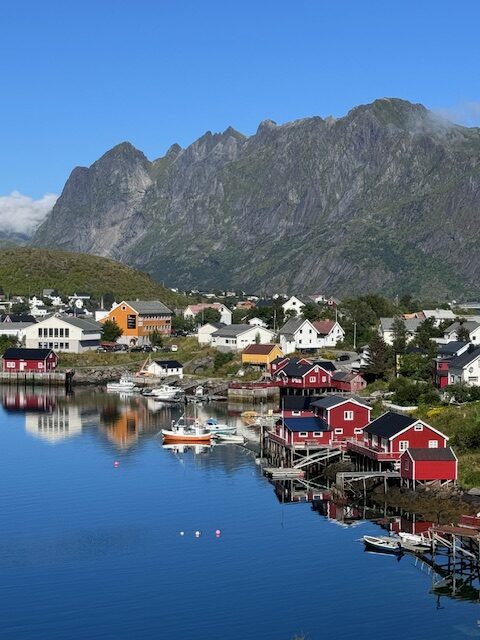

Recommended Stay: Three nights
Moskenes is located in the heart of Norway’s Lofoten archipelago. The area is a paradise for outdoor enthusiasts, offering a wide range of summer activities surrounded by breathtaking natural beauty. The dramatic landscape, characterized by towering mountains, deep fjords, and picturesque fishing villages, provides an ideal setting for hiking.
Popular nearby trails include Reinebringen and Kvalvika. Reinebringen is a short but challenging hike that rewards climbers with panoramic views of the surrounding fjords and the village of Reine below. Kvalvika’s trailhead is about 30 minutes away from Moskenes and takes hikers to a secluded stretch of white sand beach. It is a popular place for backpackers who go overnight camping. Less than thirty minutes away is the village of Ramberg which also has a long stretch of white sand beach and turquoise water.
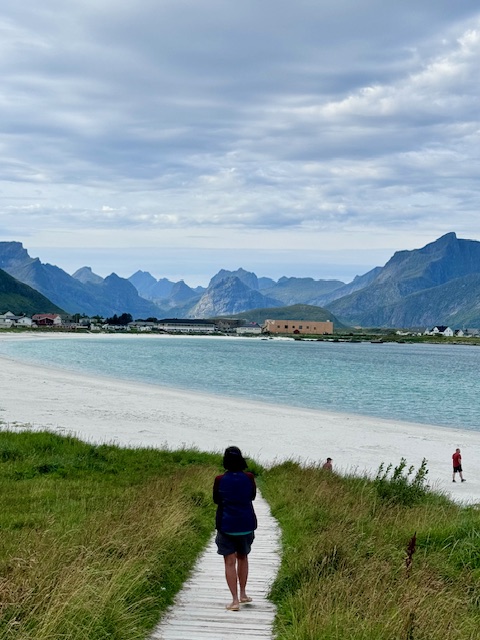

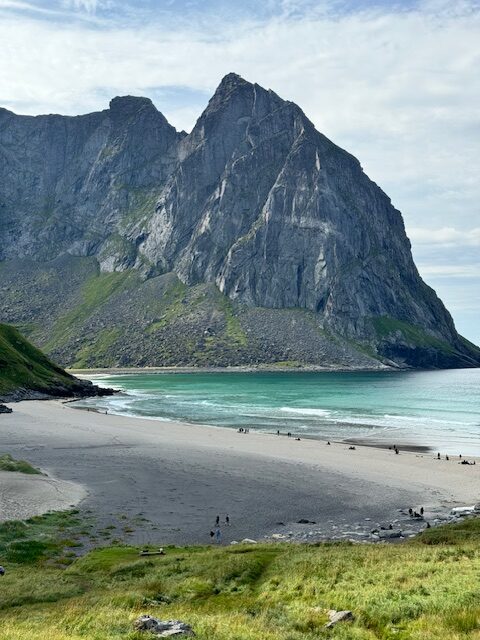

For those who prefer water-based activities, the coastal waters around Moskenes are perfect for kayaking, fishing, and boating. Kayaking allows visitors to explore the archipelago’s intricate coastline, discovering hidden bays, narrow inlets, and dramatic sea cliffs. Fishing is deeply rooted in the local culture, and summer offers excellent conditions for sea fishing, where you can catch cod, halibut, and other species. Boat trips to nearby islands, such as Værøy or the remote fishing village of Å, offer additional opportunities to experience the region’s natural beauty and rich maritime heritage.
The Midnight Sun, which bathes the landscape in continuous daylight during the summer months, creates a unique atmosphere for evening hikes, photography, or simply relaxing by the sea.
Whether exploring the dramatic landscapes on foot, paddling through crystal-clear waters, or soaking in the serene midnight light, Moskenes is an unforgettable summer destination in the Lofoten Islands.
Bodø


Recommended Stay: Two nights unless you plan to do more hiking
We left the Lofoten Islands by taking the morning ferry from Moskenes to Bodø. We made Bodø a destination because of Saltstraumen, one of the strongest tidal currents in the world that produces giant whirlpools. The whirlpools are at their strongest when the tides peak. You would have to time your visit. Best place to see the whirlpools is by walking along the bridge where you have a bird’s eye view of the churning water.
If you want to be closer to the action, boats take visitors on a thrilling ride across the swirling waters. Underneath the bridge, shore anglers try their luck on catching fish.
Bodø is also surrounded by mountains and fjords. There are plenty of hiking trails near the city.


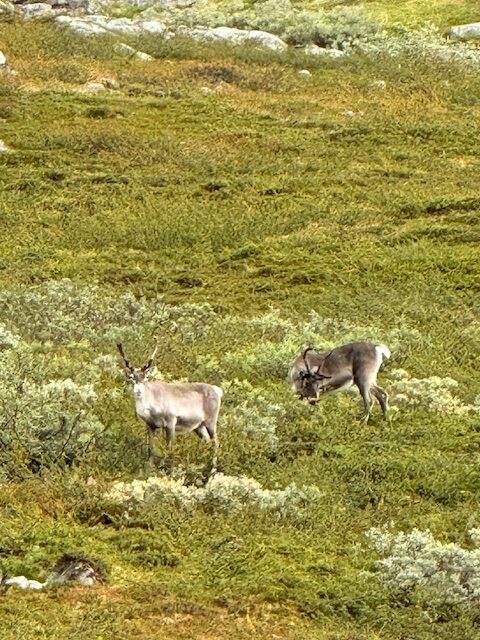

Bodø is just over two hours drive from the Arctic Circle Center. The center is a big souvenir store selling articles that focus on the famous imaginary line. There is also a large wooden structure just outside of the souvenir store that serves as the Arctic Circle monument.
What is pleasantly surprising is that reindeers can be seen in this area.
Similar to other places in Northern Norway, Bodø is also a great base for outdoor activities or experiencing the midnight sun.
Tromsø
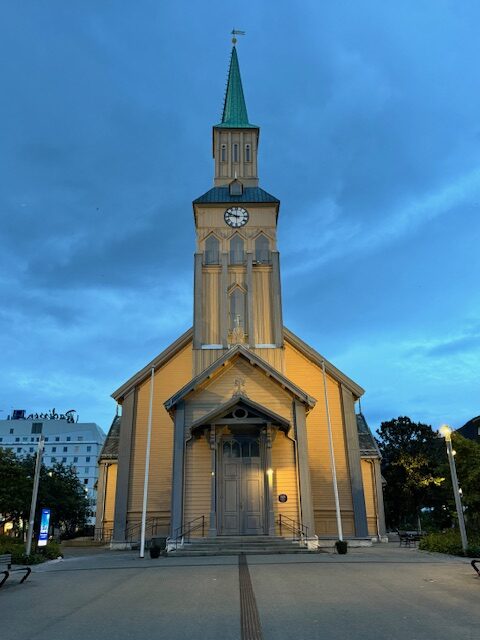

Recommended Stay: Three nights
Tromsø is often referred to as the “Gateway to the Arctic” and is actually more popular in the winter because it is a great place to see the Aurora Borealis or Northern Lights. Our AirBnB host in Tromsø said that there are more tourists in the winter than the summer. So better make early lodging and car reservations if you plan to go to Tromsø in the winter. Our host also said that January and February are the best months to see the aurora.
Tromsø in the summer offers a wealth of summer outdoor activities that allow visitors to experience the region’s stunning natural beauty and unique Arctic environment. One of the most popular activities is hiking, with trails that cater to all levels of experience. The hike up to Mount Storsteinen via the Sherpa Steps is a favorite, providing spectacular views over Tromsø and the surrounding islands.


We stayed in Tromsø because we wanted to do the 8.4 kms (round trip) Blaisvatnet Jiehkkejari or Blue Lake hike. The trailhead is about an hour and half from Tromso if you time the ferry correctly. Otherwise, you may have to wait for an hour or two as there is only one ferry that shuttles vehicles.
Blue Lake is a nice destination and has beautiful scenery. The jade colored water reminds us of Lake Louise in Banff, Canada. Plus you can see the glacier and its several waterfalls. However, the path to get to the lake is terrible. Though there is no significant ascent to get to the lake, there is about an hour long walk over rocks and stones that takes a toll on your feet. We would never do this hike again.
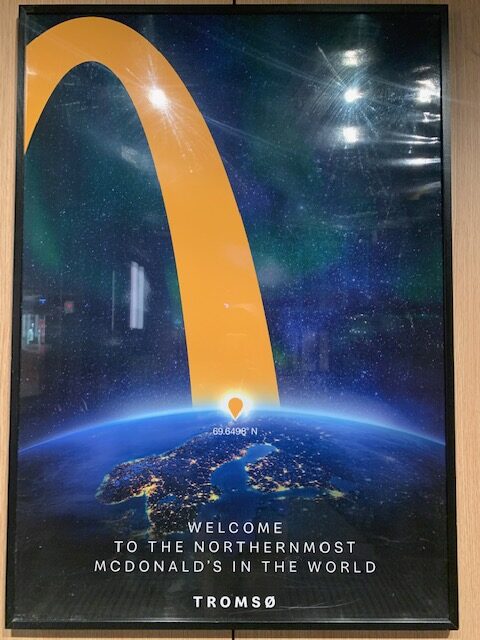

Tromsø has a nice downtown area. The shops close early but the restaurants remain open at night. We were pleasantly surprised going into the local McDonalds which has a sign that states “Welcome to the Northernmost McDonald’s in the World”.
Watch your speed and the road while driving in Tromsø. It has an abundance of speed cameras.
Whether exploring rugged mountains, paddling through serene waters, or basking in the glow of the Midnight Sun, Tromsø offers an unforgettable summer outdoor experience in one of Norway’s most picturesque regions.
Summary
Norway is a great destination to experience the outdoors and fantastic scenery. Deep fjords, colorful lakes, towering mountains provide an unlimited variety of outdoor experience. To make it really special, the country throws in the Midnight Sun during the summer for an unforgettable experience.
In Southern Norway, Lysebotn, Odda, Ulvik, Sandane, Åndalsnes and Trondheim were great places to visit.
In the north, you probably would not go wrong to stay anywhere in Senja Island. Svolvaer, Moskenes, Bodø and Tromsø were all great destinations.

